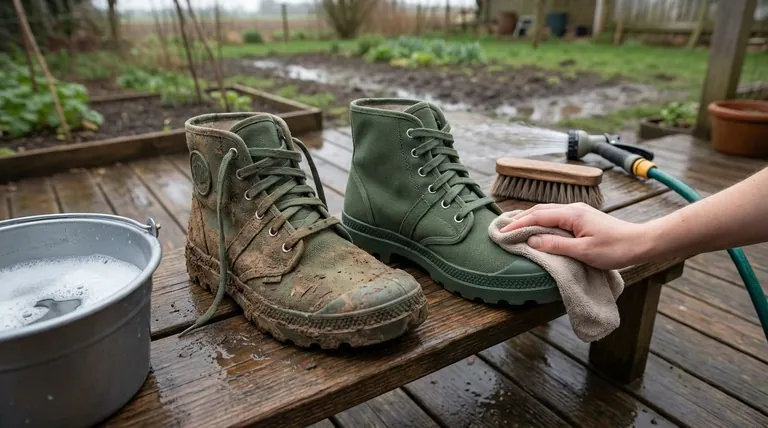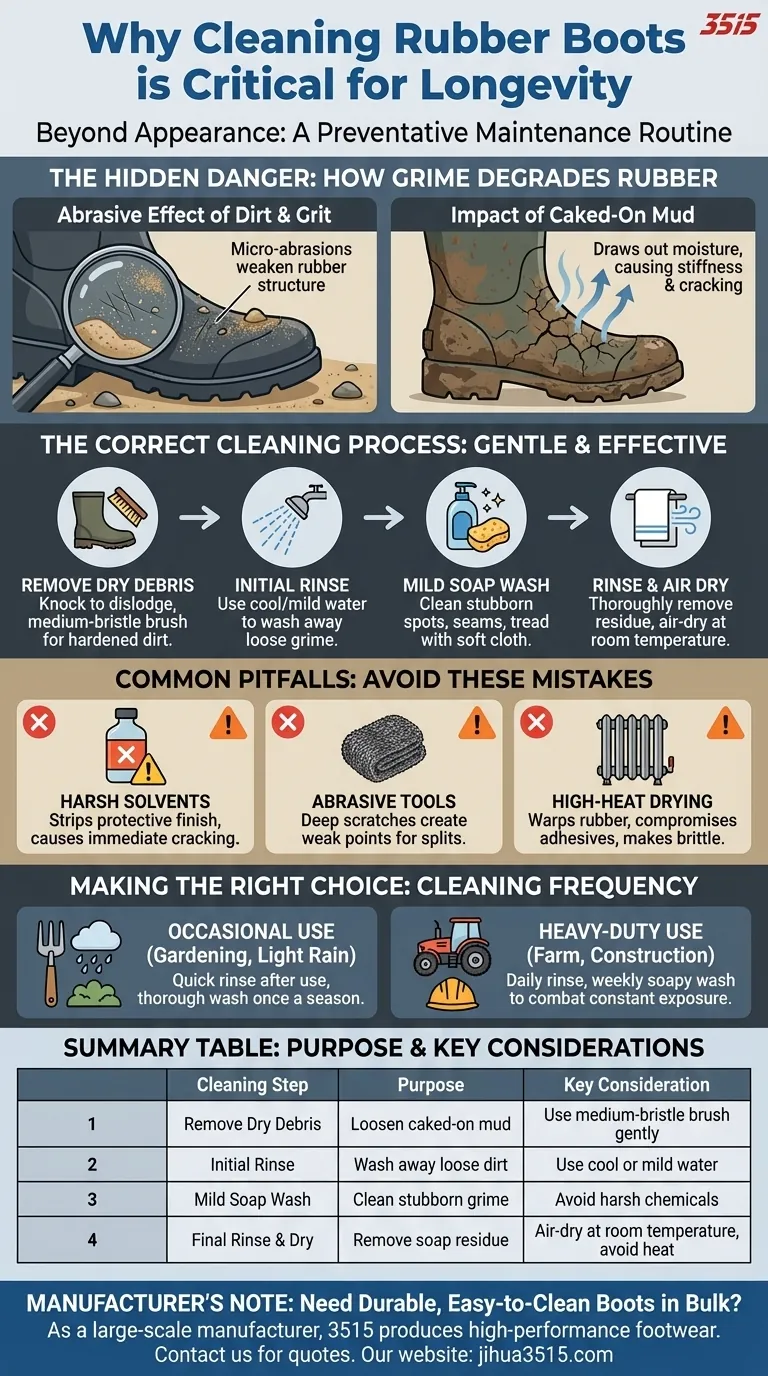Beyond just appearance, cleaning your rubber boots is a critical maintenance task that directly impacts their longevity and performance. Failing to clean them allows abrasive dirt and chemical contaminants to slowly degrade the natural rubber, leading to premature cracking, loss of flexibility, and eventual leaks.
Regular cleaning is not about aesthetics; it's a preventative maintenance routine. By removing abrasive dirt and chemical contaminants, you protect the rubber from degradation and ensure your boots remain waterproof and flexible for years to come.

How Contaminants Degrade Natural Rubber
Understanding how everyday grime damages your boots reveals the true importance of cleaning them. The breakdown is a physical and chemical process that occurs over time.
The Abrasive Effect of Dirt and Grit
Dried mud, sand, and small bits of grit act like fine-grit sandpaper. With every step you take, these particles rub against the surface of the boot, creating micro-abrasions that weaken the rubber.
The Impact of Caked-On Mud
Thick layers of dried mud do more than just look messy. They can draw essential moisture and plasticizers out of the rubber, accelerating the drying process and causing the material to become stiff and brittle, especially at key flex points around the ankle and toes.
The Correct Cleaning Process: Step-by-Step
A proper cleaning method is gentle on the rubber but tough on grime. Following these steps ensures you remove contaminants without causing additional harm.
Step 1: Remove Dry Debris
First, knock the boots together to dislodge any large, caked-on chunks of mud. Use a medium-bristle brush to gently scrub away any remaining hardened layers of dirt.
Step 2: Perform an Initial Rinse
Using cool or mild water, rinse the entire surface of the boots. This washes away all the loose dirt and prepares the surface for a deeper clean if necessary.
Step 3: Use a Mild Soap Solution
For stubborn grime, a simple solution of mild soap and warm water is all you need. Apply it with a soft cloth or sponge, paying special attention to the seams and tread.
Step 4: Rinse and Wipe Dry
Thoroughly rinse all soap residue from the boots, as leftover soap can also degrade the rubber over time. Finish by wiping the boots clean with a non-abrasive cloth.
Common Pitfalls to Avoid
What you don't do is just as important as what you do. Avoiding these common mistakes is crucial for preserving your boots.
Harsh Solvents and Cleaners
Never use chemical solvents, detergents, or abrasive cleaners on your boots. These products can strip the protective finish and natural oils from the rubber, causing it to dry out and crack almost immediately.
Abrasive Scrubbing Tools
Avoid using steel wool, scouring pads, or overly stiff brushes. These can create deep scratches on the boot's surface, creating weak points where cracks and splits can begin to form.
High-Heat Drying Methods
Never place your boots near a radiator, direct heat vent, or in intense, direct sunlight to speed up drying. High heat can warp the rubber, compromise the adhesives, and cause the material to become brittle. Always let them air-dry at room temperature.
Making the Right Choice for Your Goal
Your cleaning frequency should match your usage pattern to provide the right level of protection.
- If your primary focus is occasional use (e.g., gardening, rainy days): A quick rinse after each use and a more thorough cleaning once a season is sufficient to maintain them.
- If your primary focus is heavy-duty use (e.g., farm work, construction): A daily rinse to remove debris and a weekly soapy wash is essential to combat constant exposure to abrasive elements.
Consistent care is the single most effective way to protect your investment and ensure your boots perform when you need them most.
Summary Table:
| Cleaning Step | Purpose | Key Consideration |
|---|---|---|
| Remove Dry Debris | Loosen caked-on mud | Use a medium-bristle brush gently |
| Initial Rinse | Wash away loose dirt | Use cool or mild water |
| Mild Soap Wash | Clean stubborn grime | Avoid harsh chemicals and solvents |
| Final Rinse & Dry | Remove soap residue | Air-dry at room temperature; avoid heat |
Need durable, easy-to-clean rubber boots in bulk? As a large-scale manufacturer, 3515 produces a comprehensive range of high-performance footwear for distributors, brand owners, and bulk clients. Our expertise ensures your boots are built to last and easy to maintain. Contact us today to discuss your specific needs and get a quote!
Visual Guide

Related Products
- Factory-Direct Wholesale Canvas Boots with High-Traction Rubber Soles
- Factory Direct Wholesale Rain Boots Durable Waterproof & Fully Customizable
- Wholesale Waterproof Tactical Boots Custom Suede & High-Traction Soles
- Premium Wholesale Tactical Style Safety Shoes Boots with Quick Lacing
- Wholesale Durable Mid-Cut Tactical Boots for Custom & Private Label Brands
People Also Ask
- What is a vulcanized sole? Discover the Secret to Superior Flexibility and Grip
- Why are rubber soles beneficial in cold-weather boots? Superior Traction & Waterproofing
- What types of work environments are hiker-style rubber outsoles best for? Ideal for Outdoor & Industrial Safety
- Why is rubber a popular material for shoe soles? Unbeatable Grip, Durability & Value
- What should be avoided when storing boots with outsoles? Protect Your Investment from Dry Rot & Decay



















